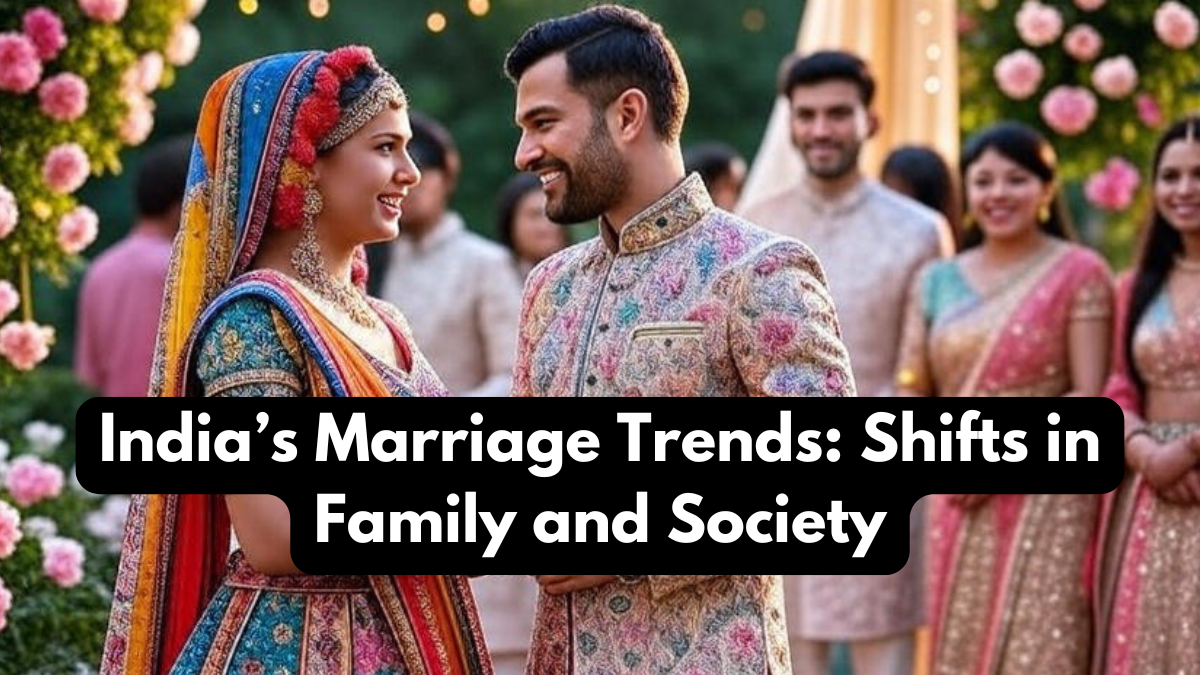Indian marriage trends are undergoing a dramatic shift as modern values meet traditional customs. In India, marriage has long been a cornerstone of society, defining not just family structures but also cultural and economic ties. However, the 21st century is bringing visible social change, altering how young people approach relationships, partnerships, and marriage itself. What was once seen primarily as a union between families is now increasingly shaped by individual choice, urban lifestyles, and evolving gender roles.

Changing Dynamics of Indian Marriage Trends
Historically, marriages in India were arranged by families, with emphasis on caste, community, and economic background. While these elements remain significant in many regions, Indian marriage trends today reflect growing acceptance of love marriages, inter-caste unions, and cross-cultural partnerships. Education, economic independence, and exposure to global lifestyles have contributed to this social change. The younger generation is prioritizing compatibility, emotional connection, and mutual respect over rigid social rules.
Some of the major drivers of this transformation include:
- Higher literacy rates and professional opportunities for women.
- Urbanization and migration, exposing individuals to diverse cultures.
- Widespread use of social media and dating apps.
- Increased focus on personal freedom and career growth.
Regional and Urban-Rural Differences
Despite progress, these shifts are not uniform across the country. In metropolitan areas like Delhi, Mumbai, and Bangalore, Indian marriage trends lean strongly towards individual choice and nuclear families. In contrast, rural India still follows more traditional frameworks, though even there, social change is slowly taking root. Families are gradually becoming more open to inter-community marriages, and younger voices carry greater weight in decision-making.
Here is a comparative look at how marriage preferences differ between urban and rural areas:
Aspect |
Urban India (Cities) |
Rural India (Villages) |
|---|---|---|
Type of Marriage |
More love marriages and inter-caste unions |
Mostly arranged marriages |
Role of Family |
Advisory, but individual choice dominates |
Strong family control |
Gender Expectations |
Focus on equality and shared roles |
Traditional gender roles still emphasized |
Influence of Technology |
High use of dating apps and online forums |
Limited, but growing with smartphone use |
Influence of Social Change on Family Structures
One of the most striking impacts of evolving Indian marriage trends is the shift from joint families to nuclear families. Younger couples prefer independence, privacy, and flexibility in managing careers and finances. While this transition reflects social change, it also brings challenges such as reduced support from extended families and increased pressure on couples to balance work and personal life.
Marriage is no longer seen only as a duty to family or society but as a partnership rooted in shared goals. This cultural shift is also affecting wedding ceremonies—many young couples opt for intimate celebrations rather than grand traditional functions, prioritizing meaningful experiences over societal display.
The Road Ahead for Marriage in India
Looking forward, Indian marriage trends will continue to reflect a blend of tradition and modernity. While cultural roots remain strong, social change is pushing families to rethink rigid norms. Inter-faith marriages, late marriages, and even couples choosing to remain unmarried are gradually gaining acceptance. The younger generation is less afraid to break stereotypes, creating a future where marriage is based more on choice than compulsion.
Conclusion
The evolution of Indian marriage trends illustrates how deeply personal decisions are shaped by broader social change. India is moving from a society where marriage was primarily a family arrangement to one where individual aspirations and mutual respect define relationships. This shift does not erase tradition but redefines it in a way that better reflects the realities of modern life. The journey ahead will continue to balance cultural values with personal freedom, reshaping marriage into a partnership of equals.
FAQs
What are the main factors driving change in Indian marriage trends?
Education, urbanization, gender equality, and exposure to global lifestyles are some of the strongest drivers reshaping marriage patterns.
How is social change influencing Indian marriages?
Social change is encouraging families and individuals to prioritize compatibility, emotional connection, and shared values over caste or community restrictions.
Are arranged marriages still common in India?
Yes, arranged marriages are still prevalent, especially in rural areas, but they are increasingly flexible, with young people having a stronger say in partner selection.
How are urban and rural marriage trends different?
Urban marriages are more likely to be based on individual choice, equality, and the use of technology, while rural marriages still largely follow traditional frameworks.
Click here to learn more